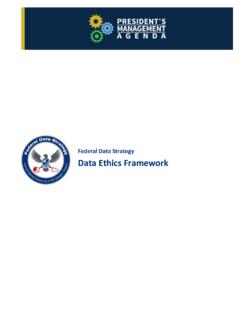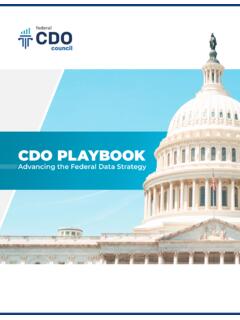Transcription of Federal Data Strategy Data Governance Playbook
1 July 2020 Federal data Strategy data Governance Playbook Federal data Strategy data Governance Playbook Page 2 Contents Federal data Leadership .. 3 data Leadership 4 Play 1: data Governance .. 5 Step 1 establishing a data Governance Body .. 5 Step 2 Setting the Vision .. 7 Play 2: data and Related Infrastructure Maturity .. 9 Step 1 Conducting a data Maturity Assessment .. 9 Step 2 establishing Agency data Architecture Guidance .. 11 data Governance Resources .. 13 Implementation Timeline, Metrics, and Related Practices .. 13 Federal data Strategy data Governance Playbook Page 3 Federal data Leadership data plays an increasingly important role in our modern world and new approaches to gathering, analyzing and using data are transforming the way Federal agencies fulfill their missions and serve the nation.
2 This expansion in data use poses challenges for how agencies execute data -related activities as each agency faces a different set of infrastructure challenges, abides by different mission parameters, and maintains a unique culture. In this evolving environment, working with data and data management have become disciplines key to organizational success. The importance of data is reflected in new legislative focus on ensuring that agencies are effectively incorporating data in fulfilling their missions. For example, the Foundations for Evidence-Based Policymaking Act of 2018 (hereinafter Evidence Act ) requires that CFO Act agencies1 develop a learning agenda plan every four years as part of their strategic plan.
3 These learning agendas identify agency key questions based on consultation with internal and external stakeholders, give agencies the opportunity to identify key questions related to mission and operations, and include short- and long-term questions. By using data to address key questions, agency leaders can develop evidence-based solutions to organizational challenges and improve mission and operational outcomes. Effective data leadership is critical to the success of the learning process envisioned in the Evidence Act. The Federal data Strategy (hereinafter Strategy ) supports a coordinated approach to Federal data leadership, including data use and management, to help agencies deliver on mission in the 21st century.
4 By guiding agencies in establishing more consistent and integrated data infrastructure and data practices, the Strategy seeks to move the Federal Government toward fully leveraging data as a strategic asset, including supporting strong data Governance and providing the data protection and security the American people deserve. The Strategy consists of a mission statement articulating the intent and core purpose of the Strategy , 10 principles serving as motivational guidelines, and 40 practices informing agencies on leveraging the value of data . The mission statement, principles, and practices are presented in final form in Office of Management and Budget (OMB) Memorandum M-19-18, and additional detail regarding their deployment can be found at This Playbook will help agencies implement the Strategy and fulfill the requirements of the Evidence Act by improving their organizsational leadership for leveraging data as a strategic asset.
5 1 This Evidence Act provision applies to the 24 CFO Act agencies named in section 901(b) of title 31: The Departments of Agriculture, Commerce, Defense, Education, Energy, Health and Human Services, Homeland Security, Housing and Urban Development, Interior, Justice, Labor, State, Transportation, Treasury, Veterans Affairs, the Environmental Protection Agency, National Aeronautics and Space Administration, Agency for International Development, General Services Administration, National Science Foundation, Nuclear Regulatory Commission, Office of Personnel Management, small Business Administration, and Social Security Administration. Federal data Strategy data Governance Playbook Page 4 data Leadership Playbook This Playbook supports agencies in developing organizational infrastructure and identifying first steps toward a coordinated and integrated approach to using data to deliver on mission, serve the public, and steward resources while respecting privacy and confidentiality.
6 This is not an easy task, given that each agency has a unique culture, level of data and related infrastructure maturity, and human and fiscal resource capacity to develop the systems necessary to use data in a transformative way. The two plays included here are designed to help agencies improve their organizational leadership for leveraging data as an asset and respond to the requirements of the Evidence Act. Each play includes activities for building data infrastructure through data Governance bodies and maturity assessments. These activities create the foundation for developing a data -driven culture in which agencies are poised to embrace the Strategy s mission statement, principles, and practices.
7 The two practices addressed in this Playbook are: Practice 11 - Prioritize data Governance : Ensure there are sufficient authorities, roles, organizational structures, policies, and resources in place to transparently support the management, maintenance, and use of strategic data assets; and Practice 15 - Assess Maturity: Evaluate the maturity of all aspects of agency data capabilities to inform priorities for strategic resource investment. It is critical that all agencies make progress on data Governance and maturity. This Playbook describes these activities in a recommended order: 1. Play 1 data Governance a. Step 1: establishing a data Governance body b.
8 Step 2: Setting the vision 2. Play 2 data and Related Infrastructure Maturity a. Step 1: Conducting a data maturity assessment b. Step 2: establishing agency data architecture guidance These plays are not intended to be strict, prescriptive recipes that require exact enactment. Rather, each agency should consider its current organizational environment, structure, culture, and capacity to decide how to implement the plays. Agencies should prioritize and adapt the individual checklist items in ways that make the most sense for their own organization. In addition, implementing these plays should create significant organizational learning, especially in the initial years, so agencies should plan to regularly review and update their data Governance approach and ensure it supports their learning agenda.
9 Federal data Strategy data Governance Playbook Page 5 Play 1: data Governance Step 1 establishing a data Governance Body What? data Governance is the process of setting and enforcing priorities for managing and using data as a strategic asset. A data Governance body with authority and oversight over the management of agency data assets is a key piece of data infrastructure. These bodies are commonly called by such names as data Governance Boards, data Councils, or data Strategy Teams. The data Governance body establishes policies, procedures, and roles for developing, overseeing, and coordinating data management policy and helps prioritize data resource allocations to answer agency key questions and meet stakeholder needs.
10 When? An effective data Governance body is foundational to leveraging data as a strategic asset and a critical precursor to making conscious and realistic decisions about stewarding data assets and developing related data infrastructure. Agencies should make establishing a data Governance body a top priority, thereby setting up the organizational structure to address data and related infrastructure needs. Who? A data Governance body is authorized and chartered by the agency head or delegated authority, chaired by the Chief data Officer (CDO), and includes senior staff with responsibility for diverse aspects of data management as well as senior officials from agency program areas.






